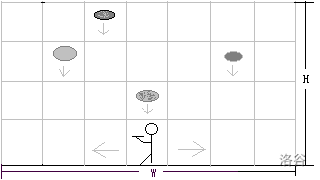P7302 [NOI1998] 免费的馅饼
P7302 [NOI1998] 免费的馅饼
题目描述
SERKOI 最新推出了一种叫做“免费馅饼”的游戏:游戏在一个舞台上进行。舞台的宽度为 \(w\) 格(从左到右依次用 \(1\) 到 \(w\) 编号),游戏者占一格。开始时游戏者可以站在舞台的任意位置,手里拿着一个托盘。下图为天幕的高度为 \(4\) 格时某一个时刻游戏者接馅饼的情景。

游戏开始后,从舞台天幕顶端的格子中不断出现馅饼并垂直下落。游戏者左右移动去接馅饼。游戏者每秒可以向左或向右移动一格或两格,也可以站在原地不动。
当馅饼在某一时刻恰好到达游戏者所在的格子中,游戏者就收集到了这块馅饼。当馅饼落在一个游戏者不在的格子里时该馅饼就消失。
写一个程序,帮助我们的游戏者收集馅饼,使得所收集馅饼的分数之和最大。
提示
对于 \(100\%\) 的数据,\(1 \leq w \leq 10^8\),\(1 \leq n \leq 10^5\),\(1\leq t_i \leq 10^8\),\(1\leq p_i \leq w\),\(1\leq v_i \leq 1000\)。
Solution:
有趣 dp 题。
首先我们不难想到拆绝对值:
令 \(t_{j} \le t_{i}\) 对于 \(i\) 所有合法的 \(j\) 应该满足:
然后我们整理一下:
$ \Longrightarrow $
$ \Longrightarrow $
$ \Longrightarrow $
$ \Longrightarrow $
也就是说,如果上述两种情况都被满足了,那么这个 \(j\) 就一定合法
即只要满足
然后怎么做?当然是线段树优化 dp 了,我们先对所有点以 \(2t_{i}-p_{i}\) 为关键字排序,然后开一颗线段树,在区间 \([1,2t_{i}+p_{i}]\) 上查询 \(f_{j}\) 的最大值。将当前答案 \(f_{i}=f_{j}+w_{i}\) 挂在线段树下标 \(2t_{i}+p_{i}\) 上。
然后这题就做完了
Code:
#include<bits/stdc++.h>
const int N=1e5+5;
const int inf=3e8;
using namespace std;
inline int Max(int x,int y){return x > y ? x : y;}
inline int Min(int x,int y){return x < y ? x : y;}
struct Node{
int tim,dis,w;
bool operator <(const Node &e)const{
return 2*tim-dis < 2*e.tim-e.dis;
}
}q[N];
int n,m,cnt;
struct Segment_Tree{
int cnt,rt[N];
struct Tree{
int ls,rs,val;
}t[N*32];
void pushup(int x){t[x].val=Max(t[t[x].ls].val,t[t[x].rs].val);}
void upd(int &x,int l,int r,int pos,int val)
{
if(!x)x=++cnt;
if(l==r){t[x].val=Max(t[x].val,val);return;}
int mid=l+r>>1;
if(pos<=mid)upd(t[x].ls,l,mid,pos,val);
if(mid<pos) upd(t[x].rs,mid+1,r,pos,val);
pushup(x);
}
int query(int x,int l,int r,int L,int R)
{
if(L<=l&&r<=R){return t[x].val;}
int mid=l+r>>1,res=0;
if(L<=mid)res=Max(res,query(t[x].ls,l,mid,L,R));
if(mid<R) res=Max(res,query(t[x].rs,mid+1,r,L,R));
return res;
}
#undef ls
#undef rs
}T;
int f[N];
void work()
{
cin>>n>>m;
for(int i=1;i<=m;i++)
{
scanf("%d%d%d",&q[i].tim,&q[i].dis,&q[i].w);
}
sort(q+1,q+1+m);
cnt=m;
for(int i=1;i<m;i++)
{
if(q[i].dis==q[i+1].dis&&q[i].tim==q[i+1].tim)q[i+1].w+=q[i].w,q[i]={inf,inf,inf},cnt--;
}
sort(q+1,q+1+cnt);
for(int i=1;i<=cnt;i++)
{
f[i]=q[i].w;
f[i]=T.query(T.rt[0],-inf,inf,-inf,2*q[i].tim+q[i].dis)+q[i].w;
T.upd(T.rt[0],-inf,inf,2*q[i].tim+q[i].dis,f[i]);
//cout<<"pos:"<<2*q[i].tim-q[i].dis<<" "<<2*q[i].tim+q[i].dis<<"="<<f[i]<<"\n";
}
int ans=0;
for(int i=1;i<=cnt;i++)ans=Max(ans,f[i]);
printf("%d", ans);
}
int main()
{
//freopen("P7302_3.in","r",stdin);freopen("P7302.out","w",stdout);
work();
return 0;
}



 浙公网安备 33010602011771号
浙公网安备 33010602011771号